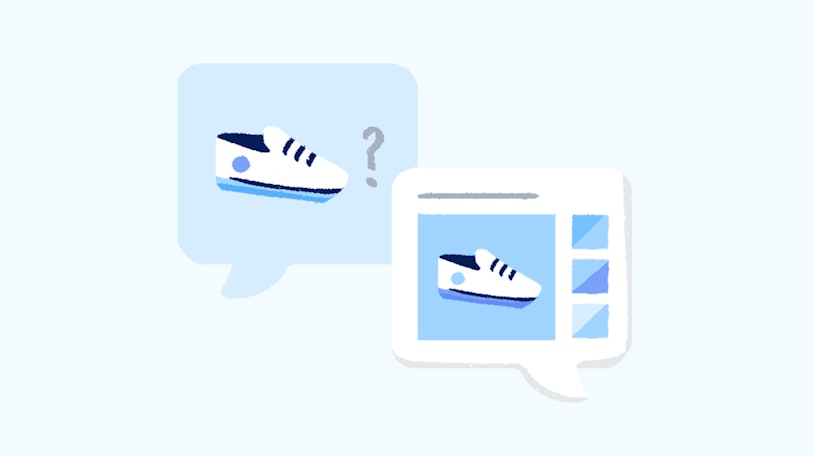Since the very beginning of commercial artificial intelligence products, customer service has been considered an obvious place to deploy AI, replacing those (relatively) costly and squishy humans with nice, clean, infinitely scalable computer software.
Back in 2020, in the first version of this article, we didn’t think that customer service professionals had too much to fear from AI. But now it is 2024, and lawyers are using ChatGPT to cite (imaginary) cases. What’s the current state of play for customer service and AI? Let’s find out.
What do we mean by AI-powered customer service?
Artificial intelligence is a broad term that can encompass many different technologies. When talking about AI in customer service, we’re typically referring to Machine Learning (ML) and the Large Language Models (LLM) it enables, as well as Natural Language Processing (NLP).
Machine Learning involves giving machines access to sources of data and having them “learn” the information without being explicitly programmed. In the case of LLMs, there are two phases of training. The first layer uses massive amounts of public data including books, articles, websites, and other sources.
In the second training phase, a model can be fine tuned using a narrower set of data that is specifically suited to the intended use of the model. Customer service interactions generate large amounts of reasonably structured data as customers ask questions and support teams answer them, meaning that it could theoretically be a good training source to use. Machine Learning allows a system to take in all of that data, and train itself to answer questions.
Often answering questions means using additional technology like NLP. NLP is how computers are able to parse and “understand” written human languages in customer service emails, phone calls, or chats, enabling software to make decisions or take actions based on that understanding.
There are many more individual technologies that tend to be grouped under the AI banner, but in recent times LLMs have garnered all the press. Let’s take a look at some commonly used approaches to adding AI into the customer service process.
Different models for AI-powered customer service
What comes to mind when you think about artificial intelligence? When HAL 9000 refused to help Dave in 2001: A Space Odyssey? Perhaps the Johnny Cabs from Total Recall?
The reality is likely to be far less dramatic, but AI can be engaged in many forms within customer service. There is no “best” way to implement AI; instead there are different approaches to be considered.
Replace the human with a convincing bot
This model is what underlies the “robots will take all the customer service jobs” fear. It assumes that AI will soon be so advanced that no humans need to be involved, and customers will be able to talk to support without knowing or caring whether it’s a person or a piece of software on the other end.
Advantages: If you have the considerable scale and resources to implement and continually improve a high-quality system, it can lend to long-term cost savings and allow for faster customer service in many locations. This is particularly if your customers tend to ask a lot of pretty similar questions with clear answers.
Disadvantages: While ChatGPT and its ilk can create very convincing human-sounding text, it is still prone to hallucinations — inventing answers and confidently passing them off as truth. For most use cases, letting a bot handle conversations on its own is too unpredictable to rely on today.
AI in the front, people in the back
Any customer service professional knows there are plenty of repetitive questions to be handled. This model places AI tools as the first line of support to customers, handling the most common and most simple questions. Anything more complex or that fails to be resolved is handed off to the human team.
Advantages: When well-implemented, this model allows scaling up the front-line support volume at a low cost and reserves the more expensive, creative, human-powered support for second-tier questions.
Disadvantages: The human support team will often find themselves dealing with customers who have already had a bad experience with a chatbot that failed to help them. It also means missed opportunities to try different approaches and learn from the more common questions.
Using AI to augment humans
Think of this model as the “Tony Stark + Jarvis = Iron Man” approach. It keeps support teams directly in contact with customers, but it makes those teams faster and more effective by equipping them with AI-powered contextual data and solutions. For example, AI might summarize complex issues, categorize incoming support, and suggest relevant help documents or sample answers.
It places AI in the role of a highly skilled assistant, collecting all the information and sorting through it, while still allowing the support agent to decide what to pass on to the customer and how to do it.
Advantages: This approach retains person-to-person service and allows for support teams to connect with customers and make judgement calls about the right approach, making them more informed with less effort.
Disadvantages: Even though each agent can be faster and more effective, you do still need to invest in hiring and training the right people to take advantage of that power.
At Help Scout, we believe that for small and medium-sized customer-centric businesses, the best role for AI in delivering customer service is to empower the people who provide that service. There are many ways to obtain value from AI in customer service without having AI ever reply directly to your customers. For example, AI could be used to:
Show your agent the most useful knowledge base articles based on the customer’s question.
Automatically categorize or tag incoming questions to save time.
Discover patterns in your customer service reporting that might better help plan schedules or manage your team.
Help triage incoming support and suggest priority cases.
Of course, no real-world implementation of AI-powered customer service will fit cleanly into one model. Every company will need to look at their existing capabilities and the tools and services available in the marketplace.
The state of AI play in 2024
The public release of ChatGPT in November of 2022 marked a shift in momentum for applied AI in every industry. When non-technical people could log onto a website and have a real-time back and forth conversation with an AI that (mostly) made perfect sense, it was like the future had arrived all at once.
Hundreds or thousands of businesses were launched to apply AI to every conceivable area of life, and when it comes to marketing phrases, “AI-powered” is the new “internet-enabled.” Every application, every service is considering the role of AI now and in the future.
There are serious ethical and moral concerns about AI, but there are very few people reading this who could confidently say AI will not be involved in their work lives, if it is not already.
So, is AI coming for your customer service job?
Yes. But also not really.
Yes, AI will absolutely impact your customer service job in some way. That is inevitable in customer service as it is in most fields. To get specific: Whenever you’re answering a customer question thinking “if they had just read the docs, they would not have needed to even ask”, that’s work that AI could probably be doing today.
If that is the only sort of work you’re doing today, then it probably is time to look for other options. Many businesses who currently create very mediocre support through underpaid, under-resourced humans will happily shift over to mediocre support created by cheaper AI tools.
No, AI will not be completely replacing human-powered customer service roles. It may reduce the number of people required by helping people to be more efficient. It will change the role that people play by handling the work that is most repeatable, most automatable, and least requiring of creativity and empathy.
AI can elevate and release customer service professionals into new roles that develop their skills, increase their impact, and improve their ability to participate in proactive, revenue-generating activities.
It’s not only customer service professionals who are looking ahead to a world where AI is embedded in their field. Lawyers are having the same discussion and coming to a similar conclusion: The people who can adapt to use AI as a tool to deliver better work will thrive.
The biggest opportunity for bots and AI in high-value customer service is helping to make our human-powered support more informed, more responsive, and more efficient. The less time we spend searching past conversations and repeating ourselves, the more time that’s left for human connection and relationship building.
Artificial intelligence is (part of) the future of customer service
While the marketing around it can be a little breathless, we’re still in the early days of artificial intelligence. It has clear potential to help companies deliver better service, and even at its best, AI will never be a “switch it on and fire all the staff” type of product for most situations.
For most companies, there are huge customer service improvements to be gained in areas like smarter processes, cleaner data capture, CRM capabilities, and providing your team with contextual data. AI can both make use of all of those improvements and be used to create them.
Your career in customer service is going to become more challenging, more valuable, and more interesting if you’re willing to take the ride.






